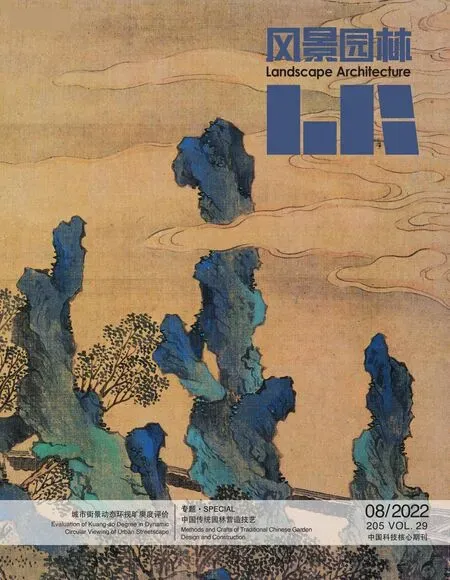中国传统园林营造技艺

中国传统园林作为宝贵的文化艺术遗产,历经数千年的发展,不断推陈出新、升华完美,形成独树一帜的“中国山水园”,具有重要的国际地位和文化影响。文化的传承与创新是永恒的时代话题,如何实现传统园林的继承与发展,并在新时代的人居环境营造中发挥更大的作用?对于营造技艺的挖掘和总结是一条重要途径。
中国传统园林的营造技艺,涉及选址布局的理论、叠山理水的手法、树木花卉的造景和建筑小品的式样,以及巧于因借的技巧等,是一个综合的艺术体系,在古代已经达到完美精深的程度。对于这套营造体系,今天应该如何认知,并在深入认知的基础上融入当下的风景园林创作呢?
老一辈学者在研究和实践两方面都做出了杰出的示范。1951年汪菊渊先生联合吴良镛先生筹备创建“造园组”,他亲自负责中国古代园林史课程,并编写了《中国古代园林史纲要》教材。教材的最后一章是“试论我国山水园林和园林艺术传统”,展示了汪菊渊先生对于传统造园技艺的思考和总结。这一章包括5节内容:我国的园林创作的特色、传统的布局原则和手法、关于掇山置石、关于理水和水法、关于植物题材,自上而下、从普遍到具体地论述了如何运用传统技艺,营造“美的自然和美的生活境域”。
汪菊渊先生总结的5节内容中,“关于掇山置石”一节的篇幅远远超出其他各节,反映了山石技艺在汪先生心中的地位。叠山置石确实是最具中国特色、艺术成就最高的一项技艺。童寯先生的《江南园林志》将“造园”和“假山”并列,各占一章。曹汛先生指出:“我国的自然山水园,无不以再现自然山壑为主要意趣。……一部造园艺术史,也就注定和叠山艺术史同步”,表达了与童先生一致的观点。
孟兆祯先生是“造园组”第二届学生,曾向汪菊渊先生请教学习中国传统园林应从何处入手?汪菊渊先生强调:中国传统园林最难学的就是假山。受此影响,孟兆祯先生选择假山作为研究重点,通过收集学习前人的著作,与假山师傅切磋交流,攻坚克难,循序渐进,先后发表了《山石小品艺术初探》《假山浅识》《北海假山浅释》等文章,总结出7条传统假山的艺术理论,提出3种传统假山“古为今用”的方法,在假山研究领域做出了重要的贡献。理论需要与实践相结合,孟先生进而将研究心得应用于设计实践,创作出北京奥森公园林泉奥梦假山、杭州花圃岩芳水秀假山等经典作品,取得了突出的成就。
假山叠石是传统园林营造技艺最可宝贵的部分,不过仅有叠山还无法营造完整的园林。叠山要与理水结合,水使景物生动起来,所谓“山得水而活”。有山有水,还要有树木花草,所谓“山得草木而华”。山、水、植物构成园林的自然环境,在此基础上还要有可居可留的亭台楼阁,作为供人活动的人工环境。刘敦桢先生指出,古典园林中的建筑具有使用与观赏的双重作用,“山池是园林的骨干,但欣赏山池风景的位置,常设在建筑物内”。汪菊渊先生将以上各种要素总结为,通过“因山就水来布置树木花草,亭榭堂屋,互相协调地构成切合自然的生活境域,并达到‘妙及自然’的境界”。
研究传统园林的营造技艺,既可以按山、水、植物、建筑做分类的挖掘,更需要将它们合成一个整体,获得综合性的把握。孟兆祯先生借鉴传统的造园理法,将园林的设计序列总结为明旨、相地、立意、布局、理微和余韵6个环节,并以借景作为核心,与各个环节构成紧密的整体,称作“孟氏六涵”。这套凝练了中国传统造园内质的规划设计理法体系,对于今天的创作实践具有直接的指导意义。
中国传统园林蕴含着中华优秀文化基因。如今许多的中国传统园林,如皇家的避暑山庄、颐和园,私家的拙政园、网师园等都已被列为世界文化遗产,贯穿于它们内部的营造技艺作为“非物质文化遗产”,同样值得重视。非物质文化遗产是一个国家和民族的智慧结晶和精华,也是这一文化遗产能否继续传承,并影响到当下和未来的关键。这提醒我们既要注重传统园林实体的保护和修复,又要重视传统造园技艺的挖掘和传承,还要关注造园匠师的研究和培养,从而形成从园林实例到造园技艺再到传承人的完整体系。
从20世纪上半叶以来,经过几代学者的努力,中国传统园林的研究从无到有、由浅入深,已经获得到了丰硕的成果。在此基础上,今天的学者正在将相关研究推向新的阶段,以中国传统园林营造理念及其技艺为切入点,必将为当代的普遍实践提供更有效的借鉴。

Methods and Crafts of Traditional Chinese Garden Design and Construction
As the valuable cultural and artistic heritage, traditional Chinese gardens have been innovating and perfecting in thousands of years of development,forming unique “Chinese Landscape Gardens” with important international status and cultural influence. The inheritance and innovation of culture is an eternal topic of the times. How to inherit and develop traditional gardens so that they can play a greater role in the construction of human settlements in the new era? It is an important way to explore and summarize the construction crafts.
The construction crafts of traditional Chinese gardens are a comprehensive artistic system, which has been perfected in ancient times,involving the theory of site selection and layout, the technique of mountain and water management, the pattern of trees and flowers, the style of architecture, as well as the skills of making landscape according to local conditions, etc. How should we recognize this construction system today and integrate it into the current landscape architecture creation on the basis of in-depth cognition?
Scholars in the past have made remarkable achievements in both research and practice. In 1951, Wang Juyuan, together with Wu Liangyong,set up the “Garden Group”. In addition, he taught the course of History of Ancient Chinese Gardens and compiled the textbookOutline of History of Ancient Chinese Gardens. The last chapter of the textbook is “landscape garden and landscape art tradition in China”, which shows Wang Juyuan’s thinking and summary of the traditional gardening skills. This chapter is composed of five sections: “characteristics of landscape creation in China”,“principles and techniques of traditional layout”, “setting of mountains and stones”, “water management”, and “plants”, which, from top to bottom and from general to specific, discuss how to create “beautiful nature and beautiful life” with traditional skills.
In these five sections, the length of the section “setting of mountains and stones” far exceeds the other sections, highlighting the position of mountain and stone setting skills in Wang Juyuan’s mind. The setting of mountains and stones is indeed a skill of the most Chinese characteristics and artistic achievements.Jiangnan Gardensby Tong Jun puts “gardening”and “rockeries” in the same important position, elaborating on them using one chapter respectively. “All natural landscape gardens in China are all dedicated to reproducing natural mountains,” Cao Xun said, “the history of garden building art is destined to be synchronized with the history of mountain building art.” These words echoed the views of Tong Jun.
Meng Zhaozhen, as a student of the second batch of the “Garden Group”, once asked Wang Juyuan where to start learning traditional Chinese gardens. Wang replied that the most difficult thing to learn about traditional Chinese gardens is the rockery. Affected by Wang, Meng chose rockery as the focus of research and made important contributions in the field of rockery research. Through studying predecessors’ works and communicating with rockery masters, he overcame numerous difficulties and published a lot of articles, such as “A Preliminary Study on Rockery Art”, “On Rockeries”,and “The Interpretation of the Rockeries in Beihai Park”, summed up seven theories of traditional rockery art, and proposed three methods of applying traditional rockery in modern construction. Theory needs to be applied to practice. Meng then applied his research ideas to design practice, and made outstanding achievements by creating classic works such as “Linquan Aomeng” Rockery in Beijing Olympic Forest Park, “Yanfang Shuixiu”Rockery in Hangzhou Flower Nursery Garden.
Rockery design is the most valuable part of traditional garden construction skills. Yet a complete garden cannot be made by stacking mountains alone.Mountain and rockery creation should be combined with water management since water gives life to scenery, just as the saying that “Mountains become alive because of water”. In gardens, there should be not only mountains and water,but also trees and flowers, just as the saying that “mountains become colorful because of vegetation”. In addition to the mountains, water and plants that constitute the natural environment, the garden should also be equipped with habitable pavilions to serve as an artificial environment for human activities. Liu Dunzhen considered that the buildings in classical gardens have dual functions of use and appreciation, saying “Mountain and water are the pillar of the garden, but the place to appreciate it is always inside the building”. Wang Juyuan summarized the functions of the above elements and believed that “plants and buildings should be arranged according to the mountains and water so that they can coordinate with each other to create a life domain that conforms to the nature and reach the natural realm”.
The research on the construction technology of traditional gardens should not only classify mountains, water, plants and buildings, but also integrate them into a whole to obtain a comprehensive grasp. Referring to the traditional gardening method, Meng Zhaozhen summed up the design sequence of the garden into six links: “Mingzhi (Understanding the purpose), Xiangdi (Locating),Liyi (Theme setting), Buju (Layout proposing), Liwei (Detailing) and Yuyun(Polishing and adorning) and connected each link into a tight whole with the view borrowing as the core, which is called “Meng’s six connotations”. This system, which integrates the planning and design principles of traditional Chinese gardens, has a direct guiding significance for today’s practice.
China’s traditional garden contains unique Chinese outstanding culture.Nowadays, many traditional Chinese gardens, such as the imperial gardens “the Mountain Resort of Chengde”, “Summer Palace”, the private gardens “the Humble Administrator’s Garden”, “the Master-of-Nets Garden” etc., have been listed as World Cultural Heritage, and the construction techniques running through them are also worthy of attention as “intangible cultural heritage”.Intangible cultural heritage is the essence of the wisdom of a country and a nation, and it is also the key to whether this cultural heritage can continue to be passed on and affect the present and future. This reminds us that we should not only pay attention to the protection and restoration of traditional garden entities, but also attach importance to the inheritance of traditional gardening skills, and the cultivation of garden builders, so as to form a complete system from gardens to gardening skills and then to inheritors.
Since the first half of the 20th century, with efforts of several generations of scholars, the study on traditional Chinese garden has grudually become fruitful, from shallow to deep. On this basis, today’s scholars,centering on concepts and skills of traditional Chinese garden construction,are advancing relevant research, aiming to provide more effective reference for the contemporary practice.
Editor-in-Chief: Professor ZHENG Xi
July 29, 2022

